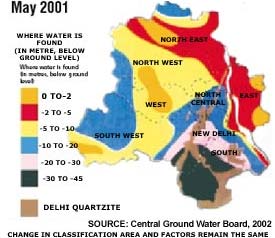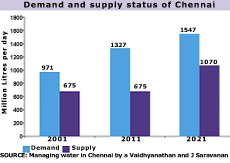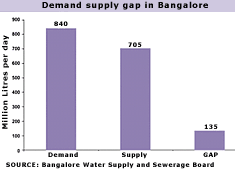Even though the rate of urbanisation in India is among the lowest in the world, the nation has more than 250 million city-dwellers. Experts predict that this number will rise even further, and by 2020, about 50 per cent of India's population will be living in cities. This is going to put further pressure on the already strained centralised water supply systems of urban areas. The urban water supply and sanitation sector in the country is suffering from inadequate levels of service, an increasing demand-supply gap, poor sanitary conditions and deteriorating financial and technical performance.
According to Central Public Health Engineering Organisation (CPHEEO) estimates, as on 31 March 2000, 88 per cent of urban population has access to a potable water supply. But this supply is highly erratic and unreliable. Transmission and distribution networks are old and poorly maintained, and generally of a poor quality. Consequently physical losses are typically high, ranging from 25 to over 50 per cent. Low pressures and intermittent supplies allow back siphoning, which results in contamination of water in the distribution network. Water is typically available for only 2-8 hours a day in most Indian cities. The situation is even worse in summer when water is available only for a few minutes, sometimes not at all.
Image by: Rajesh Dangi
What a stress?
According to a World Bank study, of the 27 Asian cities with populations of over 1,000,000, Chennai and Delhi are ranked as the worst performing metropolitan cities in terms of hours of water availability per day, while Mumbai is ranked as second worst performer and Calcutta fourth worst (Source: Background Paper - International Conference on New Perspectives on Water for Urban & Rural India - 18-19 September, 2001, New Delhi.) In most cities, centralised water supply systems depend on surface water sources like rivers and lakes. Chennai, for instance, has to bring in water from a distance of 200 km whereas Bangalore gets its water from the Cauvery river, which is 95 km away. Where surface water sources fail to meet the rising demand, groundwater reserves are being tapped, often to unsustainable levels.
 |
 |
In Delhi approximately 13 per cent (Source: Zerah., M Helene, 2000, Water - Unreliable Supply in Delhi, French Research Institute of India) households do not receive water every day and in Rajkot, Gujarat, water availability in April 2000 was only for 30 minutes every alternate day.
 |  |
 |
The other major resource is groundwater from the well fields in the Araniar-Kortaliyar basin and the southern coastal aquifer, and a large number of wells and tubewells spread all across the city. Over-extraction of groundwater in the north western coastal belt resulted in a rapid ingress of seawater, which extended from 3 km inshore in 1969 to 7 km in 1983 and 9 km in 1987. Groundwater levels within the city also fell and brackish water began to appear even in localities which earlier had good quality groundwater sources.
 |
SOURCES OF WATER:
Surface water:
| Source | Design capacity (MLD) | Present withdrawl (MLD)3 |
| 1.Arkavathy river a) Hesarghatta b) T.G.Hally | 36 148 | 6.0 36.0 |
| 2.Cauvery river a) Stage-I b) Stage-II c) Stage-III | 135 135 270 | 135 135 270 |
| 724 | 582 |
To meet the demand supply gap, the government has already proposed to extract 770.0 MLD of water from the Cauvery river under Cauvery stage IV project (Phase I and Phase II). The production cost of this water per kilolitre is expected to be Rs. 45.70. (On completion of these phases total extraction from the Cauvery for Bangalore alone would be 1310 MLD i.e. 478 billion litres in a year or 16.78 thousand million cubic feet [TMC])
Ground water extraction: According to a study conducted by the Centre for Symbiosis of Technology, Environment and Management (STEM), a Bangalore-based research group, the demand supply gap is met by groundwater exploitation. It is estimated that 40 per cent of the population of Bangalore is dependent on groundwater.
Source:
1. http://www.rainwaterharvesting.org/Crisis/Urbanwater-scenario.htm
2.
3. A conceptual frame for rainwater harvesting in Bangalore, STEM, 2001
4. Vishwanath. S, 2000, Personal Communication
